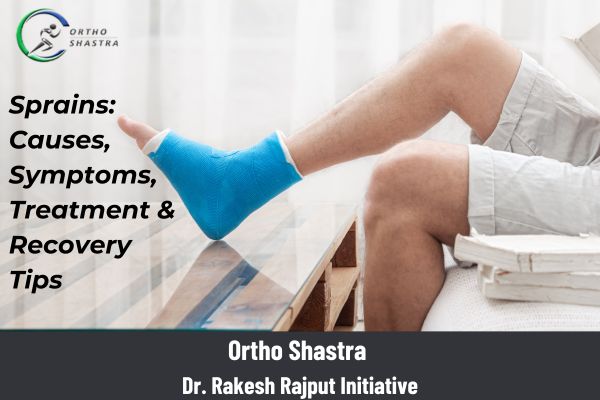Sprains: Causes, Symptoms & Expert Treatment by Dr. Rakesh Rajput
A sprain is a common soft tissue injury that occurs when a ligament—the tough band of tissue connecting bones in a joint—is overstretched or torn. Ankle sprains, wrist sprains, and knee sprains are the most frequently affected joints. While mild sprains heal with rest and proper care, severe ligament injuries may require expert treatment from an orthopedic specialist like Dr. Rakesh Rajput.
What Causes a Sprain?
Sprains typically happen when a joint is twisted, stretched, or impacted beyond its normal range of motion. Some common causes include:
✔ Sudden Twists & Falls – A misstep, uneven surface, or sports-related injury
✔ Direct Impact – Accidents or forceful blows that stress the ligaments
✔ Overextension – Stretching the joint beyond its capacity
✔ Weak Muscles & Ligaments – Lack of strength increases the risk of injury
✔ Wearing Improper Footwear – Inadequate support can cause instability
Common Symptoms of a Sprain
The severity of a sprain varies, but typical symptoms include:
Pain & Tenderness – In the affected joint, especially when moving
Swelling & Bruising – Due to inflammation and internal bleeding
Limited Range of Motion – Difficulty in movement and flexibility
Joint Instability & Weakness – The joint may feel loose or unstable
Severity Levels of Sprains:
Grade 1 (Mild): Slight ligament stretch with minor swelling and discomfort
Grade 2 (Moderate): Partial ligament tear, noticeable swelling, and difficulty in movement
Grade 3 (Severe): Complete ligament tear, extreme swelling, and joint instability
Dr. Rakesh Rajput’s Expert Approach to Sprain Treatment
Most mild to moderate sprains can be managed with the R.I.C.E. method, which is a first-line treatment recommended by Dr. Rakesh Rajput:
Rest: Avoid putting weight on the injured joint
Ice: Apply an ice pack (15-20 minutes, every few hours) to reduce swelling
Compression: Use an elastic bandage to support the joint
Elevation: Keep the affected area raised to reduce inflammation
Advanced Treatment for Severe Sprains
For severe ligament tears, Dr. Rakesh Rajput may recommend:
✔ Pain Management: NSAIDs (Ibuprofen, Naproxen) to reduce pain and inflammation
✔ Physical Therapy: Strength and flexibility exercises to restore function
✔ Bracing & Immobilization: Supporting the joint with braces or splints
✔ Minimally Invasive Surgery (If Needed): Repairing completely torn ligaments through arthroscopic procedures
Recovery Timeline for Sprains
Mild Sprains: 1-2 weeks with home care
Moderate Sprains: 3-6 weeks with physiotherapy
Severe Sprains: Several months (may require rehabilitation or surgery)
How to Prevent Sprains?
✔ Warm Up Before Exercise – Reduces strain on ligaments
✔ Wear Supportive Footwear – Prevents instability and injuries
✔ Strengthen Muscles Around Joints – Provides better joint support
✔ Improve Balance & Flexibility – Reduces the risk of accidental falls
✔ Avoid Overexertion – Listen to your body and avoid pushing beyond limits
When to See Dr. Rakesh Rajput for a Sprain?
Severe pain & swelling that doesn’t improve
Inability to bear weight on the injured joint
Numbness or tingling in the affected area
Visible deformity or extreme instability
If you have a severe sprain or ongoing joint pain, consult Dr. Rakesh Rajput, a renowned orthopedic specialist, for personalized treatment and faster recovery.
Book an appointment today and get back to an active lifestyle!

